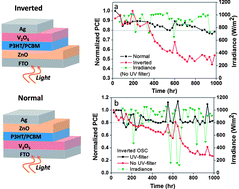Layered V2O5 hydrate has been applied as the hole transport layer (HTL) in organic solar cells (OSCs). V2O5 is obtained from a sodium metavanadate solution in water under ambient conditions, resulting in a final thin film of formula V2O5·0.5H2O. The 0.5 water molecules are not removed from the V2O5 layered structure unless the sample is heated above 250 °C, which makes the thin film highly stable under real working conditions. The HTL was used in OSCs in the normal and the inverted configurations, applying metallic Ag as the back-metal electrode in both cases. Fabrication of both OSC configurations completely by solution-processing printing methods in air is possible, since the Al electrode needed for the normal-configuration OSC is not required. The work function (WF) and band gap energy (BG) of the V2O5 thin films were assessed by XPS, UPS and optical analyses. Different WF values were observed for V2O5 prepared from a fresh V2O5–isopropanol (IPA) solution (5.15 eV) and that prepared from a 24 h-old solution (5.5 eV). This difference is due to the gradual reduction of vanadium (from V5+ to V4+) in IPA. The OSCs made with the V2O5 thin film obtained from the 24 h-old V2O5–IPA solution required photo-activation, whereas those made with the freshly obtained V2O5 did not. Outdoor stability analyses of sealed OSCs containing a V2O5 HTL in either configuration revealed high stability for both devices: the photovoltaic response at T80 was retained for more than 1000 h.

This article is Open Access
 Please wait while we load your content...
Something went wrong. Try again?
Please wait while we load your content...
Something went wrong. Try again?


 Please wait while we load your content...
Please wait while we load your content...